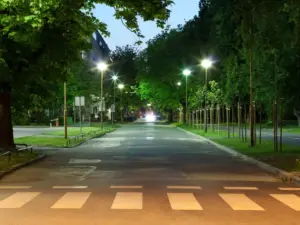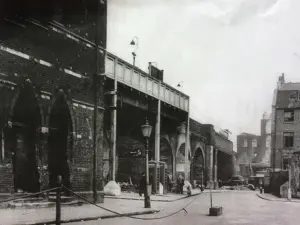Introduction:
The streets illuminated by the warm glow of electric streetlights have become a great sight in modern cities worldwide. These lights not only provide safety and security but also add a touch of enchantment to urban landscapes. The story behind the invention of the street light is a journey of innovation. It involves many inventors and contributors who paved the way for this essential aspect of modern urban life. After reading this, you may have doubts, who invented the streetlight?
But, before that, let’s understand why street lights were introduced. Please keep reading to know why and who invented the street light.
Why were the street lights introduced?

When were street lights invented? Before understanding this, we need to understand why they were invented as well. As the sun sets and darkness descends, there is a sense of safety, security, and beauty. The invention of streetlights has had a great impact on societies. Fundamentally transforming the way cities function after sunset. But why were streetlights invented in the first place? What were the driving factors behind this innovation that has become an integral part of our modern urban experience?
-
Safety and Security
One of the primary reasons behind the invention of street lights was to enhance safety and security during nighttime. In ancient times, when streets were lit by oil lamps or not lit at all, wandering through city alleys after dark could be a perilous endeavor. Street lights solved this problem, illuminating pathways, intersections, and public spaces. Well-lit streets deterred criminal activities. They reduced accidents and instilled a sense of safety for those who needed to travel after sunset.
-
Economic Growth and Productivity
The advent of street lighting also contributed to economic growth and increased productivity. Before electric street lights, cities effectively shut down after sunset. There was a limiting scope of business, commerce, and social activities. With the introduction of reliable lighting systems, shops could extend their operating hours, fostering economic activities that spanned into the night. This transformation helped shape the vibrant 24-hour cities we know today.
-
Urban Aesthetics and Social Interaction
The street light invention had a significant impact on urban and social interactions. Well-lit streets created an inviting atmosphere. People socialize and enjoy public spaces even after the sun has set. The illuminated streetscapes transformed the way cities were experienced. They turned nighttime into an opportunity for leisure, entertainment, and cultural events.
-
Technological Advancements and Progress
The invention of street lights was intricately tied to the broader technological advancements of its time. As electricity became more accessible, inventors like Joseph Swan and Thomas Edison saw the potential. Harnessing this newfound power illuminates entire cityscapes.
-
Public Health and Well-Being
Streetlights played a role in improving public health and well-being. They made outdoor spaces safer and more accessible, even during the night. Illuminated streets reduced accidents and injuries. Pedestrians and vehicles could navigate more easily. Furthermore, well-lit public areas promoted a sense of community. And it also encouraged outdoor activities, contributing to healthier and more active lifestyles.
Who Invented the Streetlight?

Ancient Beginnings: Illumination in the Dark Ages
In ancient Rome and Baghdad, oil lamps were strategically placed along streets to provide illumination. While these methods were rudimentary, they marked the early attempts to conquer the darkness. So, to be frank, the answer to the question, who invented the streetlight, is rather a collective effort. Let us see this in more detail in the following paragraphs.
The Dawn of Electric Lighting: Joseph Swan
The true transformation of street lighting began with the development of lighting technology. Whenever we ask who invented street lights, we should speak about one of the pioneers in this field. It was Sir Joseph Swan, an English physicist and chemist. Swan is credited with the invention of the incandescent light bulb with a carbon filament. In 1878, he demonstrated the practicality of his invention. He illuminated a lecture theater in Newcastle, England. This marked a significant step towards the electrification of indoor spaces.
Thomas Edison’s Brilliant Contribution
Thomas Edison was an American inventor who truly revolutionized the field. Edison’s journey to create a practical and commercially viable incandescent light bulb was marked by his hard work. In 1879, he created a long-lasting and efficient light bulb using a carbonized bamboo filament. This invention changed the way people illuminated their homes. It also laid the groundwork for public street lighting.
Edison’s Menlo Park laboratory served as the birthplace of many crucial innovations. They include developing electrical distribution systems and lighting on a larger scale. With these advancements, the practical implementation of street lights became increasingly workable. And that’s how the street light invention came to light.
The Emergence of Electric Streetlights

The first electric street lights were installed in the late 19th century, ushering in a new era of urban illumination. In 1878, the city of Paris lit up the Avenue de l’Opéra with electric arc lamps, starkly contrasting the previously dimly lit streets. London followed suit in 1879 by installing arc lamps on Holborn Viaduct.
The city of New York entered the scene in 1880 with the installation of Edison’s incandescent lamps along a stretch of Broadway. This marked a significant milestone. It showcased the adaptability of electric lighting for street illumination. Other cities quickly caught on. They realized the potential of electric street lights to enhance safety and aesthetics.
It’s important to note that the invention of the street light was not the work of a single individual. It was rather the result of collaborative efforts and continuous innovation. Joseph Swan and Thomas Edison played pivotal roles in developing the necessary technology. But the improvement of street lighting systems was carried out by various municipalities.
Conclusion:
The invention of the street light is a testament to human ingenuity and the unrelenting pursuit of progress. Joseph Swan and Thomas Edison’s contributions laid the foundation. As technology continues to evolve, so will the illumination of our streets. It will pave the way for safer, more vibrant, and energy-efficient urban environments. The journey of innovation that began with the flicker of the first electric streetlights continues to light the path ahead. So, as we discussed earlier, who invented the streetlight has no definitive answer. It was a collective effort by many people towards a better living.
